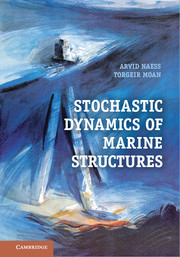Book contents
- Frontmatter
- Contents
- Preface
- 1 Preliminaries
- 2 Dynamics of Single-Degree-of-Freedom Linear Systems
- 3 Dynamics of Multi-Degree-of-Freedom Linear Systems
- 4 Finite Element Method
- 5 Stochastic Processes
- 6 Variance Spectrum
- 7 Environmental Loads
- 8 Random Environmental Processes
- 9 Response Spectrum
- 10 Response Statistics
- 11 Statistics for Nonlinear Problems
- 12 Short-Term and Long-Term Extremes
- 13 Dynamic Load Effects for Design Checks
- 14 Equations of Motion
- 15 Numerical Solution Techniques
- 16 Monte Carlo Methods and Extreme Value Estimation
- A Integrals
- B Poisson Process
- C Statistical Moments and Cumulants
- References
- Index
11 - Statistics for Nonlinear Problems
Published online by Cambridge University Press: 05 February 2013
- Frontmatter
- Contents
- Preface
- 1 Preliminaries
- 2 Dynamics of Single-Degree-of-Freedom Linear Systems
- 3 Dynamics of Multi-Degree-of-Freedom Linear Systems
- 4 Finite Element Method
- 5 Stochastic Processes
- 6 Variance Spectrum
- 7 Environmental Loads
- 8 Random Environmental Processes
- 9 Response Spectrum
- 10 Response Statistics
- 11 Statistics for Nonlinear Problems
- 12 Short-Term and Long-Term Extremes
- 13 Dynamic Load Effects for Design Checks
- 14 Equations of Motion
- 15 Numerical Solution Techniques
- 16 Monte Carlo Methods and Extreme Value Estimation
- A Integrals
- B Poisson Process
- C Statistical Moments and Cumulants
- References
- Index
Summary
Introduction
In this chapter, we discuss two types of nonlinear hydrodynamic forces on marine structures that have been subjected to extensive research since the 1970s. The first kind is related to forces on hydrodynamically slender structures, where viscous effects play a significant role. In the everyday lingo, they are just referred to as dragforces. This term would be recognized by many, not only offshore engineers. But they would perhaps be in the majority when we specialize a little more and introduce the “famous” Morison equation for the total forces on slender structures exerted by ocean waves. This equation was introduced in 1950, and is still extensively used.
The other kind of nonlinear forces that will be discussed, are the so-called second order hydrodynamic forces. They came into focus in the early 1970s due to the exploration of offshore oil fields using moored semisubmersible platforms. For the mooring of the platform, typically a kind of spread mooring system with steel ropes would be used. The consequence of this was that the natural periods of the horizontal motion modes would be of the order of minutes rather than seconds. Because there is virtually no energy in ocean waves at these periods, the only way that such slowly varying motions can occur is the existence of nonlinear hydrodynamic forces. The response pattern of offshore structures in the ocean environment indeed show that it is crucially important to be able to assess the impact of nonlinear hydrodynamic loads for the design of such structures.
Information
- Type
- Chapter
- Information
- Stochastic Dynamics of Marine Structures , pp. 252 - 274Publisher: Cambridge University PressPrint publication year: 2012
